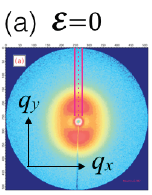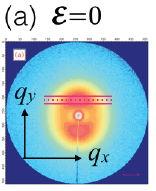Goal of the post
The second part of our project is about generating a PSP linkage of the polymers films. We had a lot of questions about how the characteristics dimensions in our data-set have been obtained and how they rare related to the SAXS and WAXS images.

The variables from the morphological domain are quantified from the X-ray scattering measurements.They are the dimension parameters and orientation parameters of crystalline and non crystalline components of the semicrystalline morphology of films at the atomistic scale (1-10 °A) and the mesoscopic scale (10-1000 °A).
Processing techniques enable the conversion of 2D data to the more useful 1D data. An integral aspect of this conversion and one that is routinely utilized in both SAXS and WAXS data is the extraction of line profiles from the 2D data.
From the SAXS images
Here are 3 examples of how this characteristics features can be extracted using line cuts.


From the WAXS images
The extraction of percentage crystallinity from 2D WAXS data is possible by evaluating the ratio of peak areas of the crystalline peaks and the total area under the scattering curve. This is conventionally achieved by first obtaining 1D line cuts of the circularly averaged 2D data and subsequently subjecting the line cuts to profile fitting. The line cuts are expected to contain crystalline peaks distributed over a broad amorphous scattering.
An analysis of Herman’s orientation parameters from the WAXS data quantifies the relative orientations of the normals to the hkl planes in the system i.e. normals to the 110 and 200 orthorhombic crystal planes.
Sources
[1]Abhiram Kannan thesis dissertaion: Structure Property Relationships in Polyethylene Blown Films.
